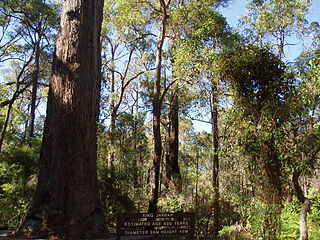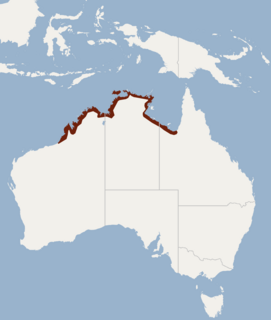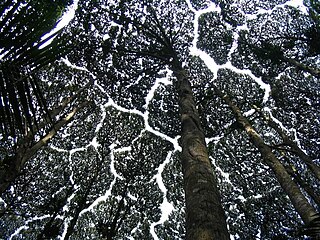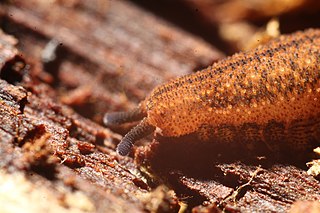
The genus Cajanus is a member of the plant family Fabaceae. There are 37 species, mainly distributed across Africa, Asia and Australasia.
Nuytsia is a peer-reviewed scientific journal published by the Western Australian Herbarium. It publishes papers on systematic botany, giving preference to papers related to the flora of Western Australia. Nearly twenty percent of Western Australia's plant taxa have been published in Nuytsia. The journal was established in 1970 and has appeared irregularly since. The editor-in-chief is Kevin Thiele.

The western swamp turtle or western swamp tortoise is a critically endangered species of freshwater turtle endemic to a small portion of Western Australia. It is the only member of the genus Pseudemydura in the monotypic subfamily Pseudemydurinae.

Jarrah Forest, also known as the Southwest Australia woodlands, is an interim Australian bioregion and ecoregion located in the south west of Western Australia. The name of the bioregion refers to the region's dominant plant community, jarrah forest – a tall, open forest in which the dominant overstory tree is jarrah.

The northern pipistrelle, also known as Koopman's or the mangrove pipistrelle, is a species of vesper bat found only in Australia. It is one of Australia's smallest bat species. On average, it weighs 3 g (0.11 oz).

Dryobalanops aromatica, commonly known as Borneo camphor, camphor tree, Malay camphor, or Sumatran camphor, is a species of critically endangered plant in the family Dipterocarpaceae. The species name aromatica is derived from Latin and refers to the smell of the dammar (resin). This species was one of the main sources of camphor and attracted early Arab traders to Borneo, at that time being worth more than gold, and used for incense and perfumes.

Aphanopetalum is a genus of twining shrubs or vines in the family Aphanopetalaceae which are endemic to Australia.

Grevillea pimeleoides is a shrub which is endemic to the south west region of Western Australia.

Keast's tube-nosed fruit bat is a species of megabat in the family Pteropodidae found in Babar, Tanimbar, and the Kai Islands.
Rhytidosteoidea is a superfamily of Temnospondyli, early amphibian species that existed during the Carboniferous, Permian, and Triassic periods. The taxon was established in 1965 to accommodate two new species of Deltasaurus, the author recognising an alliance with previously described genera.

Lycaste aromatica, common name the sweet scented lycaste, is a species of flowering plant in the genus Lycaste of the family Orchidaceae.
Gymnopilus aromaticus is a species of mushroom in the family Cortinariaceae. It was first described by American mycologist Murrill in 1917.
Lambertia fairallii, commonly known as Fairall's honeysuckle, is a shrub which is endemic to the south-west of Western Australia.
Croton aromaticus is a species of plant of the genus Croton and the family of Euphorbiaceae, native to in the Indian subcontinent. The plant is known as "Wel keppetiya - වෙල් කැප්පෙටියා" in Sri Lanka, where the roots, leaves and bark are widely used in Ayurveda for the treatments of bronchitis, diarrhoea, fever, malaria and dysentery.

Kumbadjena kaata is a species of velvet worm in the family Peripatopsidae. This species has 15 pairs of legs. The type locality is in Western Australia.
Kumbadjena occidentalis is a species of velvet worm in the family Peripatopsidae described by Joseph James Fletcher in 1895. This species has 15 pairs of legs. The type locality is in Western Australia.
Kumbadjena shannonensis is a species of velvet worm in the Peripatopsidae family. This species has 15 pairs of legs. The type locality is in Western Australia.

Rhipiceridae is a family of cedar beetles, also known as cicada parasite beetles, in the order Coleoptera. Rhipiceridae and Dascillidae form the super family Dascilloidea.
Symonanthus is a genus of flowering plants belonging to the family Solanaceae.
Symonanthus bancroftii, also known as Bancroft's Symonanthus, is a species of flowering plant in the potato family that is endemic to Australia.











